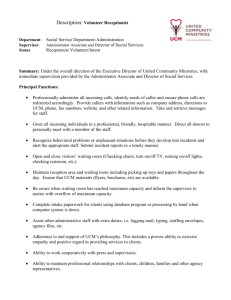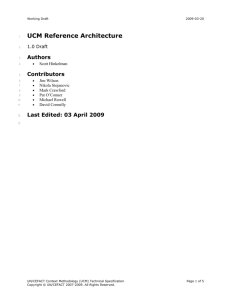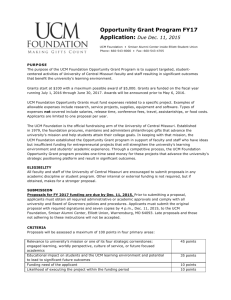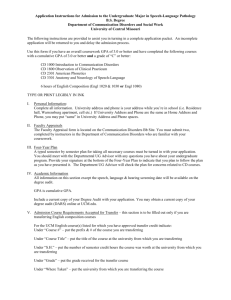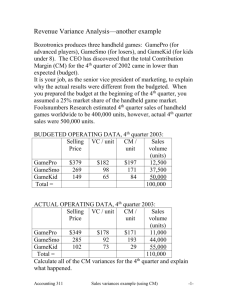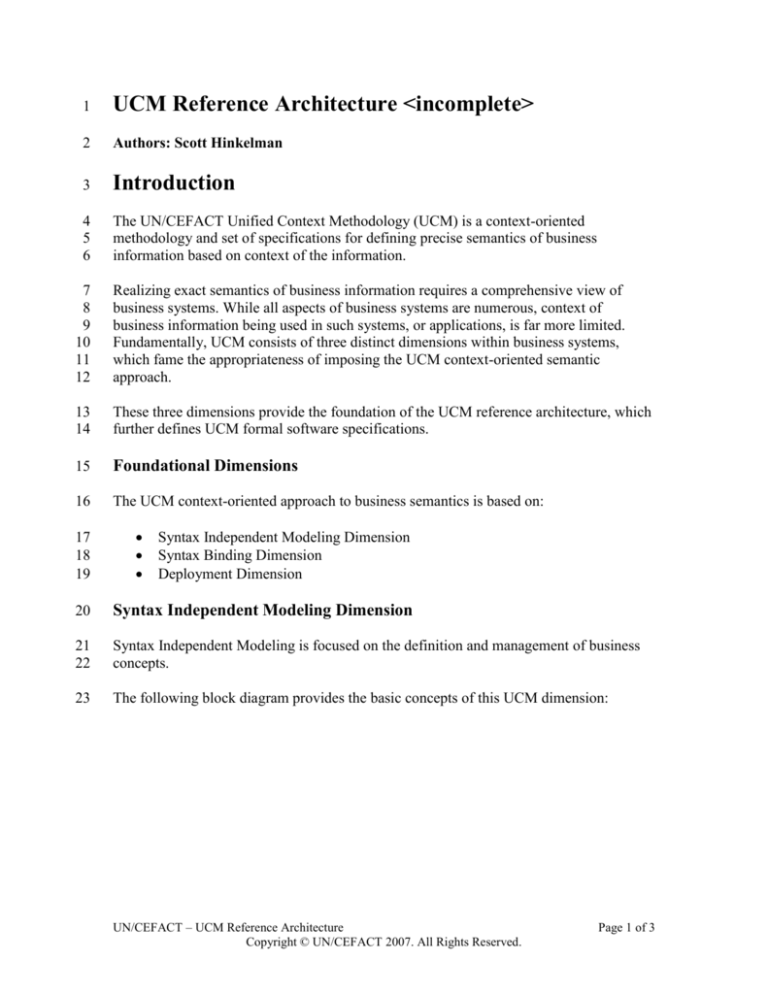
1
UCM Reference Architecture <incomplete>
2
Authors: Scott Hinkelman
3
Introduction
4
5
6
The UN/CEFACT Unified Context Methodology (UCM) is a context-oriented
methodology and set of specifications for defining precise semantics of business
information based on context of the information.
7
8
9
10
11
12
Realizing exact semantics of business information requires a comprehensive view of
business systems. While all aspects of business systems are numerous, context of
business information being used in such systems, or applications, is far more limited.
Fundamentally, UCM consists of three distinct dimensions within business systems,
which fame the appropriateness of imposing the UCM context-oriented semantic
approach.
13
14
These three dimensions provide the foundation of the UCM reference architecture, which
further defines UCM formal software specifications.
15
Foundational Dimensions
16
The UCM context-oriented approach to business semantics is based on:
17
18
19
Syntax Independent Modeling Dimension
Syntax Binding Dimension
Deployment Dimension
20
Syntax Independent Modeling Dimension
21
22
Syntax Independent Modeling is focused on the definition and management of business
concepts.
23
The following block diagram provides the basic concepts of this UCM dimension:
UN/CEFACT – UCM Reference Architecture
Copyright © UN/CEFACT 2007. All Rights Reserved.
Page 1 of 3
Working Draft
2007-10-25
24
25
26
27
28
The center of UCM context-oriented semantic modeling is two fold, and includes a
Semantic Modeling Aspect and Type/Value-Domain Aspect. While both modeling of
these aspects are intrinsic to semantic information modeling, they differ in respect to the
effect on the information entity concept, and are therefore distinct aspects within this
dimension.
29
30
31
32
33
34
35
36
37
38
39
40
41
The Semantic Modeling Aspect is the essence of the CCTS component model pattern of
specialization by restriction, where a business concept (a CC) is defined void of any
specific business context. Context(s)-specific entities (a BIE) are then defined based on a
CC by selecting a restricted set of basic and complex properties on a CC and classifying
the BIE entity definition within an instance of a classification scheme. Semantics are
realized in UCM by classification schemes which narrow the CC business concept by
classifying BIEs in increasingly specific contextual classification values. The realization
of meaning for a specific BIE is a function of the precision and granularity of the context
values defined in the instance of a context classification scheme where a given BIE is
classified, and, the specific contextual classification point where BIE was classified. It is
important to realize UCM does not specify any set of contextual classification values –
but how those values are specified and their relationships in context classification scheme
instances.
42
43
44
45
The Type/Value-Domain Aspect is the area during syntax independent modeling where
sets of specific possible types and allowed value ranges are defined. Unlike the Semantic
Modeling Aspect, Type/Value-Domain modeling does not explicitly increase the
precision of meaning of a given business concept (a CC).
UN/CEFACT – Context Methodology Technical Specification (UCM)
Copyright © UN/CEFACT 2007. All Rights Reserved.
Page 2 of 3
Working Draft
2007-10-25
46
47
48
49
50
51
As with many modeling disciplines, the two modeling aspects of UCM is inherently an
iterative process of refinement. Within this process, CC and CDT Library Aspects must
be accessed and leveraged, providing lifecycle and management of these context
independent entities. Libraries of BIEs and BDT classified in instances of context
classification schemes, which define classification values, are also directly accessible
aspects from the semantic modeling process.
52
53
54
55
56
57
Ultimately, the output product of the Syntax Independent Modeling Dimension is a
BIE/BDT Contextualized Profile. This profile is the result of interrogation of the CC/CD
Libraries, Context Values of Classification Scheme instances classifying BIEs, and
Context Libraries for a given business usage context. It is syntax independent and is
represents the semantic content source as ultimate input for the UCM Syntax Binding
Dimension.
58
59
60
The Syntax independent Modeling Dimension of UCM is fundamentally a modeling
dimension for business information experts. Appropriate UCM specifications in this area
are:
61
62
63
64
65
66
67
Context Classification Schemes – models defining how to define classification
scheme instances and the relationships of classification values for classifying
BIEs and/or references to them.
Tooling APIs for context-aware modeling to facilitate consistent software tooling
products.
BIE reference specifications to permit efficient classification and transmission of
classification scheme instances of large amounts BIEs.
68
Syntax Binding Dimension
69
<incomplete>
UN/CEFACT – Context Methodology Technical Specification (UCM)
Copyright © UN/CEFACT 2007. All Rights Reserved.
Page 3 of 3

